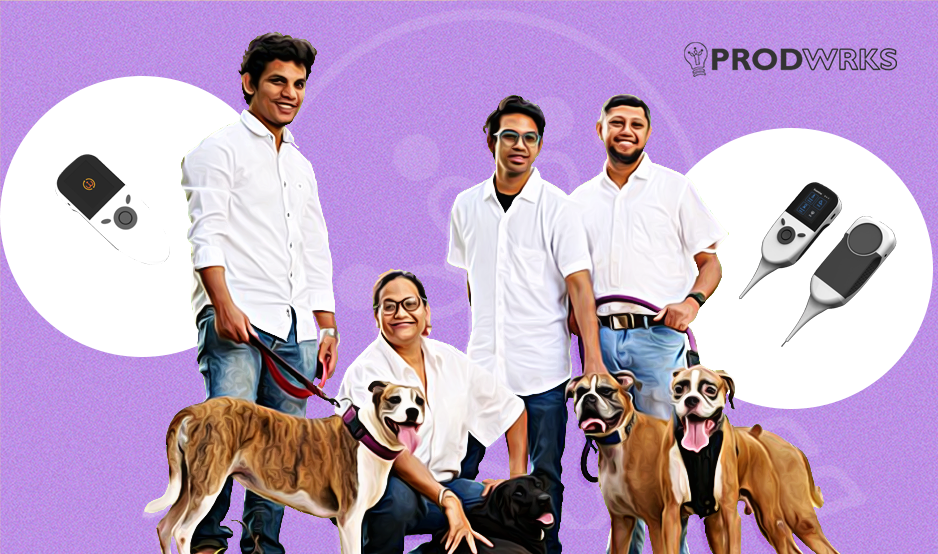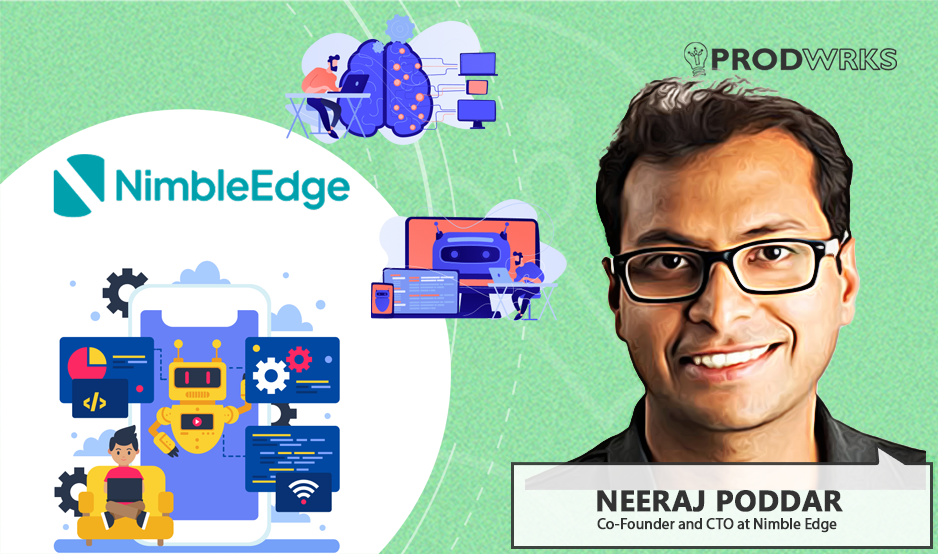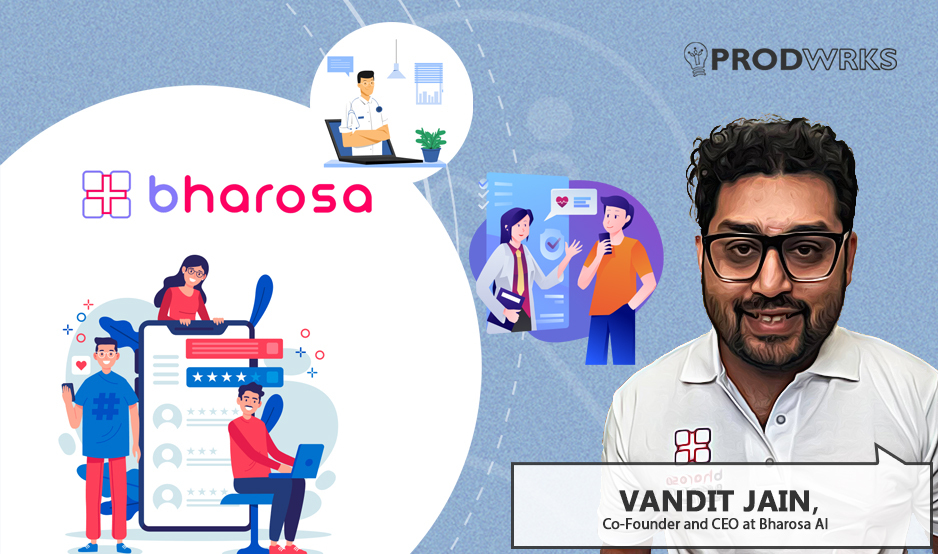
Pets are considered family, but their healthcare ecosystem lags decades behind human medicine. Often, a pet’s problems go unnoticed until it’s a full-blown illness, leading to a frantic rush to the vet. Why? Because pets can’t tell us what’s wrong. This silent suffering, leading to delayed diagnoses and overburdened vets, is a major problem that Vani Aiyer and Vivek Srinivas, founders of Vet Instant, are determined to solve.
Vet Instant is a Chennai-based startup, incubated at the prestigious IIT Madras Research Park. Their flagship product is ExamD – a palm-sized, IoT-enabled health monitor that accurately measures temperature, SpO2, heart rate, and auscultation of the heart, lungs, and abdomen of all pet animals. It’s designed for both pet parents and professional veterinary use cases to measure and manage pet health accurately.
Complementing the device is P.A.W.S. (Pets Administration and Workflow System), a SaaS software for end-to-end management of veterinary clinics. Pet vitals data measured with ExamD are automatically available in P.A.W.S.-enabled clinics. P.A.W.S digitizes care delivery and streamlines veterinary clinic operations, from appointments and inventory to AI-assisted clinical documentation and remote consultation.
ExamD and P.A.W.S., together, form a tech ecosystem that elevates pet healthcare to a level comparable to human healthcare. With 3.6 million pets in India still being managed under traditional care, the potential for Vet Instant’s solutions is immense. The startup has raised 1.55 crores in initial funding from investors, including IIT-M Incubation Cell’s Little Angels Network.
The Unspoken Crisis in Pet Health
The catalyst for Vet Instant’s startup journey was Bruno, a Boxer puppy that Vani helped Vivek acquire. Vani says, “Bruno is a very well-bred dog. Unfortunately, their health (breed dogs) doesn’t stay very well. They constantly fall sick. Bruno’s recurring skin and breathing issues were a source of constant worry.”

Through Bruno’s struggles, two critical insights emerged. "One, dogs have very high pain thresholds. They don't demonstrate pain," Vani notes. "The second was that human beings cannot identify pain in dogs easily." Subtle signs are often missed until the condition is severe.
Turns out they weren’t the only pet parents having these issues. Vani and Vivek embarked on extensive research, interviewing nearly 100 veterinarians and 1000+ pet parents across major Indian cities. The findings were starkly consistent: sudden illnesses, high costs, and the gnawing anxiety of “Is my pet okay?”
This shared frustration crystallized into a critical question. “Why do I have to know only when it’s a problem? Why can’t I know my pet’s health status in advance?” Vani questioned, articulating the frustration that would fuel their mission.
The overarching problem, Vani identified, was “the lack of digitization in the animal healthcare segment underserves the pet, vet, and pet parent.” Clinics, too, were struggling with inefficiencies, from anxious pets skewing vitals in cramped waiting rooms to the lack of trained para-veterinary staff.
The First Spark: A Wearable Dream and a Hard Reset
“We knew nothing about electronics and building a product at that stage,” Vivek admits. He was a Chartered Accountant by training and had completed the ePGP from IIM Ahmedabad. Vani, on the other hand, brought deep expertise in brand and communication. She had served as Director of the Blue Team at J. Walter Thompson (JWT), working on the Ford account, and later headed corporate communications at Nissan.
Vivek said, “A top overseas consultant we hired took six months only to declare the technology unfeasible. That's when we realized that it is not going to work if we don’t get full-time into this.”
During this period, Vivek immersed himself in learning electronics. Once committed full-time, Vivek and Vani teamed up with a Singapore-based technologist, Karthikeyan Gururaj (currently their CTO). Completing this team is a talented engineer and hands-on product designer, S Rajkumar (Raj), who is simultaneously pursuing his master’s in biomedical design at IIT Madras.

Their first task was to build a smart harness that can accurately capture heart and lung sounds comparable to the gold-standard Littmann stethoscopes used by vets worldwide. This involved intricate work with materials, electronics, and firmware. They prototyped temperature sensors and accelerometers. “The first harness we built was in Parrys (Broadway, Chennai),” Vivek chuckles, recalling a DIY approach with a local tailor.
However, the smart harness concept faced significant roadblocks. Animal movement created noise interference, and sensor placement across diverse breeds and sizes proved a Herculean task. “There was no way you could standardize it,” Vivek concluded. While simpler prototypes for a smart bowl (measuring intake) and bed (measuring weight) were developed, integrating medical-grade sensors proved economically unviable.
The Pivot to ExamD: A Handheld Revolution in Pet Diagnostics
Crucial feedback from veterinarians catalyzed a major strategic shift. While the harness was “nice to have,” vets craved “medically relevant information like accurate temperature, specific measurements.” Vani recalls them saying, “You start with something common, and it’s simple and it’s effective.”
This led to the conception of ExamD, a dedicated handheld diagnostic device that measures all core vitals: temperature, SpO2, heart rate, and auscultation of the heart, lungs, and abdomen. Vets and pet parents did not have to struggle with multiple devices to do all this.
"ExamD is like something that talks on behalf of the animal," Vani describes.

Building ExamD meant solving some very tough technical challenges:
1. Cracking Non-Invasive Temperature Measurement
Existing rectal thermometers were slow to show results (over a minute) and agitated the pets. Vet Instant partnered with the Rajiv Gandhi Institute of Veterinary Education and Research (RIVERS) in Puducherry to create a better solution to measure pet temperature.
“Every week we used to go to Pondicherry, see what the results are, then tweak the algorithm,” Vivek says. After testing on over 1000 dogs, they standardized an auricular (ear-based) temperature reading with remarkable accuracy (0.2-0.3°C variation) and speed (under a second). This was built into ExamD.
2. Perfecting Auscultation Clarity
Traditional stethoscopes did not have recording functions. ExamD initially had a single-mic system to hear and record heart, lung, and abdominal sounds. But the initial prototype struggled to find accuracy in noisy clinics.
“The sounds of the lung are like those of a violin. It has to be very finely heard,” Vani emphasizes. This led to a dual-mic system, sophisticated noise cancellation, and cloud storage for repeated listening, thereby enhancing diagnostic accuracy to hear even the most minute heart murmurs.
Raj’s design expertise was critical here, incorporating a multi-layered metal head for the stethoscope component and designing multi-mic noise cancellation systems and firmware. This took four to five months, involving meticulous work on filtering mechanisms and material science. A medical-grade silicon mat was also developed as a “jugad” (frugal innovation) to aid the right placement of the device on the pet, even by untrained pet parents.
“Getting the heart and lung sounds with the clarity that is acceptable to doctors was the first priority. The professors and doctors at RIVERS were really supportive,” Vani says.
3. Innovative SpO2 tracker
Traditionally, vets measured SpO2 with lip clips. It was problematic when vets encountered aggressive breeds like Dobermans or Rottweilers. So they were usually done under general anesthesia, which was not good for pets. Vet Instant designed a simpler, less invasive smart SPO2 tracker with sensors that can measure blood oxygen levels from the pet’s ears.
From Iterative Prototyping to Building a Market-Ready Model

The first ExamD prototype, born from experiments at RIVERS, was a “minimum experience product.” It was palm-sized, had no display, and was controlled by an app that had to be installed on a smartphone.
Vets lauded its accuracy but found the user experience cumbersome. “Hands are occupied” was the common feedback. Pet owners struggled even more as they had to hold the pet, the ExamD device, and operate their smartphones to control the device, all at the same time.
This led to ExamD’s next evolution: an integrated one-inch display with over 330 “screens”, making it a standalone device. It also bifurcated into a “Regular” version for pet parents and a “Pro” version for vets, the latter including an optional screwable rectal probe for cross-verification of body temperature, a feature specifically requested by veterinarians.
Throughout this, firmware development was a “nightmare,” according to Vani, due to the expense and scarcity of skilled engineers willing to learn deeply instead of “just relying on AI-generated code.”
Manufacturing presented its own hurdles, from sourcing PCBs from China due to high local costs and MOQs, to Raj’s hands-on approach to 3D printing and even paint jobs for prototypes, which initially cost ₹20,000 apiece to produce. The first round of funding, Rs. 1.55 crores, proved crucial in accessing top-tier freelance firmware talent.
But the team overcame these challenges to build close to 20 market-ready devices for user testing.
Feedback & Pivot to Build a Software Ecosystem for the "Holy Trinity"
Once ExamD was out in the market with real users, Vani and Vivek quickly realized that a standalone device, however innovative, wouldn’t suffice. “We have to build capabilities through software for the Holy Trinity: the pet, the pet parent, and the vet,” Vani asserts.
This holistic vision led to the development of P.A.W.S. and the VetInstant app.
VetInstant App (for pet parents): Logs health records, tracks vitals, books appointments, and will soon support remote consultations using ExamD.
P.A.W.S. (Pets Administration and Workflow System) (for clinics): Manages appointments, inventory, clinical documentation, and links seamlessly with ExamD for live diagnostics and EHR management.
The VetInstant app serves as the interface for pet parents to interact with their P.A.W.S.-enabled clinics. Currently, 10 major clinics serving close to 200,000 pets are P.A.W.S-enabled. Pet parents can book appointments, access their pet’s digitized records, and, in the future, have remote consultations with vets.
Vani says that the pivot from an IoT device maker (ExamD) to a software systems player with P.A.W.S was borne out of a pressing need for veterinary clinics grappling with systemic inefficiencies due to the sheer number of cases they get.
Vani quoted the vets’ problems: "There aren’t enough veterinarians and clinics to handle the sheer number of pets in India. The vets told us ‘Physically itself I don't have any systems to manage my workload. And you are talking about remote diagnosis and IoT? First, you build something that solves my problems in the physical clinics."
She also paints a vivid picture of challenges for pets and pet parents in clinics: “Anxiety levels for dogs shoot up. Pet parents never know when they’ll be called next. You can either meet your doctor in five minutes or you can meet your doctor in five hours.”
Many vets also lack trained para-veterinary staff, relying on “bhaiyas and didis who have been there forever.” This leads to inefficiencies and a compromised pet parent experience.
How P.A.W.S Eliminates Systemic Inefficiencies in Pet Healthcare

P.A.W.S is a comprehensive clinic management software, encompassing EHR (Electronic Health Record) and ERP (Enterprise Resource Planning) functionalities, all tailored for veterinary practices.
The system tackles core clinic pain points head-on:
1. AI-Powered Inventory Management: Inventory tracking was a major headache for clinics. “If you go to any clinic and ask for a stock statement, they’ll say, it will be ready in another two months,” Vivek illustrates. To streamline the process and reduce manual data entry, P.A.W.S. introduced AI-powered invoice scanning.
“The system can take a photo of the purchase bills and extract all the information (GST details, purchase rate, supplier details, quantity, etc.). Similarly, taking a photo of the product label captures the trade name, generic name, batch number, and barcode. It makes inventory management super simple.”
2. Appointment System & Queuing: Pet owners can book appointments via the app, and clinics can manage appointments and walk-ins. The system notifies pet parents when their turn is approaching, minimizing wait times.
3. Seamless ExamD Integration: When a pet checks in (via QR code scan from the pet owner app), their profile automatically appears on the vet’s ExamD device. Vitals taken are instantly logged into the pet’s record on P.A.W.S.
4. Clinical Documentation: Traditionally, vet documentation is sparse, often noting just the prescription and not the complete diagnosis and observations. P.A.W.S. features voice-to-medical documentation with SOAP notes for structured clinical documentation.
5. Integrated Billing: The AI system picks up medications and services from the clinical documentation, streamlining prescription generation and billing automatically.
Vani shares that their pivot to P.A.W.S. was a gamble that paid off.
"We started as an IoT device organization," Vani reflects. "Is it a pivot? We had to question ourselves a billion times." Despite internal debates and advice against diluting focus, their market understanding prevailed. "Our hunch was no, we know the market," Vivek states. "If you don't do this, there is no way that this device as a standalone will be able to succeed in India."
GTM Realities: From D2C Stumbles to Vet-Led Triumph

Vet Instant’s business model is as thoughtfully designed as its products. The ExamD Pro for vets is priced at ₹15,000 (one-time), with the consumer version anticipated to cost slightly lower. Vani pragmatically notes, “It will take time to sell… it is going to take us time to get people to accept this.”
P.A.W.S. utilizes an innovative pay-per-use model: “For every consult that clinics make, they give me 10% or 50 rupees, whichever is lower,” Vivek explains. Similar structures apply to inpatient services and retail billing. This outcome-based pricing resonated powerfully with vets.
“It should not be seen as a cost. It should be seen as a revenue enabler,” he asserts. It transformed the relationship into a partnership with “shared risk.”
Their Go-To-Market (GTM) strategy also underwent a crucial pivot. Initial attempts to sell ExamD directly to pet parents via digital marketing and cold calls (Vani herself called 800 prospects) yielded limited conversions. “People cried to me about how they lost a dog in phone calls, but nobody went and clicked the button to buy,” Vani shares candidly. “It was a very big slap in the face.”
The breakthrough came via P.A.W.S. “For most of the clinics, our ingress has been through PAWS,” Vivek confirms. Once clinics adopted the software and experienced its efficiencies, interest in ExamD followed organically. Vets became powerful advocates, eager to showcase the integrated system to their clients.
Currently, around 10 independent clinics and a large corporate entity with multiple clinics (reaching roughly 400,000 pet owners collectively, with three clinics alone accounting for 70,000) are using P.A.W.S.
The Grueling Path of DeepTech Startups and Funding Difficulties
The journey has been a testament to resilience, particularly in hardware development. “Iteration takes so much time,” Vivek laments. A single PCB revision, from design change to component sourcing (mostly imported) and printing, can take 4-6 weeks. “If I take 10 iterations, I’m actually down by two and a half years already.”
Funding this deep-tech, hardware-centric venture was another uphill battle. The breakthrough came via their incubation at IIT Madras Research Park. Initial rejections due to ExamD’s then 20,000 INR production cost spurred BOM (Bill of Materials) optimization to bring down manufacturing costs.
A revised plan led to their first institutional funding of 1.15 crores from IIT Little Angels, SIDBI, and Chennai Angels. A patent for ExamD, granted in India in January 2024 and filed in the US, further validates their innovation.
The Future: Connected Animals, Proactive Care
Vet Instant is far from done. The Pro version of ExamD is undergoing final testing, with a production run anticipated in the next 2-3 months. Consumer versions with varied features and price points will follow.
Looking ahead, Vet Instant plans to expand ExamD’s capabilities with modular add-ons like ECG and thermal imaging, and develop new non-invasive tools like a urine test kit. Their vision extends beyond companion animals to livestock, with validation for larger species already underway with RIVERS.
The core mission remains unwavering: to shift pet healthcare from a reactive, crisis-driven model to a proactive, preventive one. "Like connected cars, we wanted connected animals," Vani analogizes, drawing from her automotive experience. "We have to find a way to tell the story of their health. That’s why ExamD is so crucial. It enables preventive and predictive care in pet healthcare."
Vet Instant is not merely building devices and software; they are architecting a new, more humane, and efficient paradigm for animal well-being.
By empowering veterinarians, equipping pet parents with actionable insights, and giving pets a voice through data, they are working to ensure that the anxious question, “Anything to worry about, Dr?” is asked sooner, answered with greater clarity, and ultimately leads to better, longer lives for our beloved animal companions.



